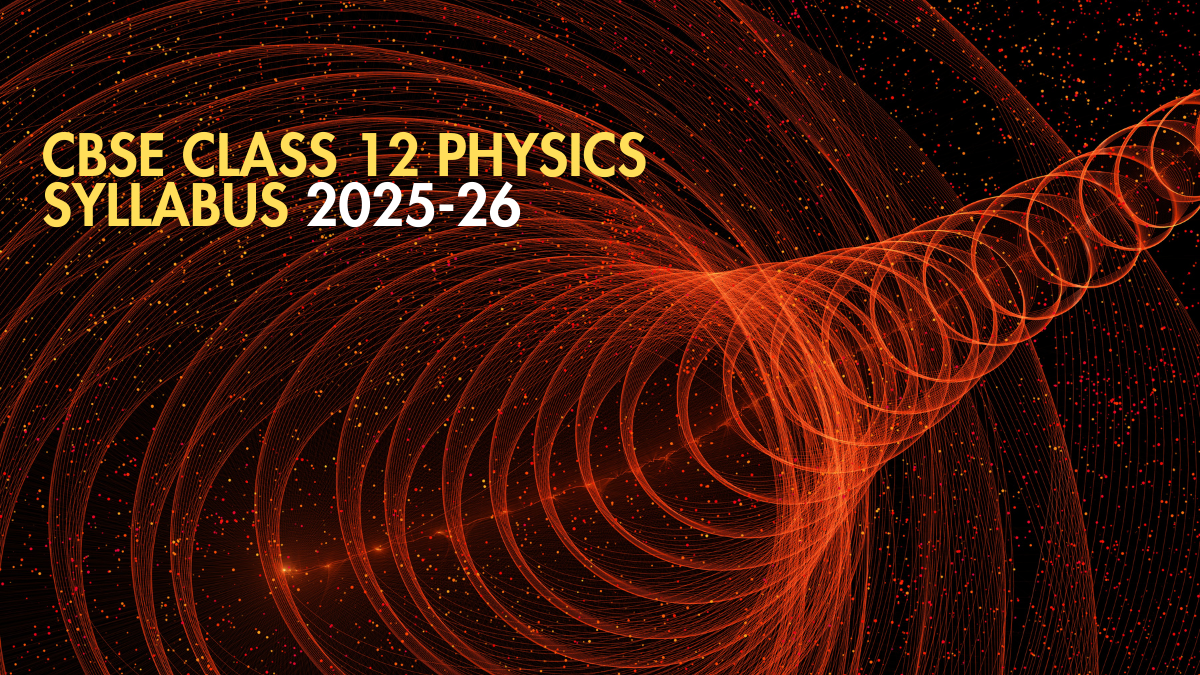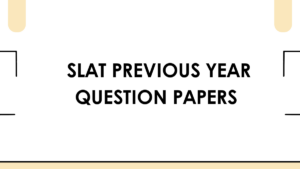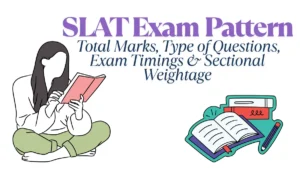The study of physics, as outlined in the CBSE Class 12 Physics Syllabus 2025-26, helps students strengthen their quantitative reasoning skills while also preparing them for a technological environment. The Central Board of Secondary Education releases the new Class 12 Physics Syllabus every year with a course structure. This article aims to give a complete idea about the redesigned CBSE syllabus of Physics.
CBSE Physics Syllabus 2025 serves as an overview, alerting students about the weightage of marks assigned to each chapter, allowing them to better organize their time. The theoretical section is worth 70 marks, while the practical section is worth 30. The 5 units and all chapters are listed below in table format.
CBSE Class 12 Physics Syllabus 2025-26
The Class 12th Physics Syllabus 2025-26 is the road map to success in the exams. You can quickly create a comprehensive study plan and begin preparing chapters accordingly with this official CBSE Class 12 Physics Syllabus PDF. Class 12 CBSE syllabus is extremely important and covers a wide range of subjects that you will need in all entrance exams. As a result, you must maintain precise focus on each subject, including the physics syllabus. When it comes to CBSE Class 12 Board Exams, every subject is difficult, but Maths and Physics take time to cover.
CBSE Physics Syllabus 2025-26 Chapter Wise Weightage
Physics is a fundamental subject for Class 12 students studying science. Class 12 Board Exams 2025-26 are the most crucial tests in a CBSE student’s life because they determine which college, university, or entrance exam they qualify for. This is why students become tense during preparation, but if you are adequately prepared with the correct syllabus and previous year papers, there is no need to worry. Check the complete CBSE Class 12th Physics syllabus with marks distribution below.
| UNIT | CHAPTERS | MARKS |
| Unit–I | Physical World and Measurement |
23
|
| Chapter–1: Units and Measurements | ||
| Unit-II | Kinematics | |
| Chapter–2: Motion in a Straight Line | ||
| Chapter–3: Motion in a Plane | ||
| Unit–III | Laws of Motion | |
| Chapter–4: Laws of Motion | ||
| Unit–IV | Work, Energy and Power |
17
|
| Chapter–5: Work, Energy and Power | ||
| Unit–V | Motion of System of Particles and Rigid Body | |
| Chapter–6: System of Particles and Rotational Motion | ||
| Unit-VI | Gravitation | |
| Chapter–7: Gravitation | ||
| Unit–VII | Properties of Bulk Matter |
20
|
| Chapter–8: Mechanical Properties of Solids | ||
| Chapter–9: Mechanical Properties of Fluids | ||
| Chapter–10: Thermal Properties of Matter | ||
| Unit–VIII | Thermodynamics | |
| Chapter–11: Thermodynamics | ||
| Unit–IX | Behaviour of Perfect Gases and Kinetic Theory of Gases | |
| Chapter–12: Kinetic Theory | ||
| Unit–X | Oscillations and Waves |
10
|
| Chapter–13: Oscillations | ||
| Chapter–14: Waves | ||
| Total | 70 | |
Physics Syllabus 2025-26 Class 12: Unit Wise
The CBSE Class 12 Physics Syllabus 2025-26 is well-structured with 5 units and 14 chapters, making it easier for students to focus on key concepts. Each unit is designed to give a clear understanding of important topics that build a strong base for exams and higher studies. To explore the complete Physics syllabus, including all the subjects and chapters covered, students can scroll down this section. This syllabus helps in planning studies smartly and preparing step by step for the board exams.
Unit I: Physical World and Measurements
Chapter–1: Units and Measurements
Need for measurement: Units of measurement; systems of units; SI units, fundamental and derived units. significant figures, Determining the uncertainty in result. Dimensions of physical quantities, dimensional analysis and its applications.
Unit II: Kinematics
Chapter–2: Motion in a Straight Line
Frame of reference, Motion in a straight line, Elementary concepts of differentiation and integration for describing motion, uniform and non- uniform motion, average speed and average velocity and instantaneous velocity, uniformly accelerated motion, velocity – time and position-time graphs. Relations for uniformly accelerated motion (graphical and calculus treatment).
Chapter–3: Motion in a Plane
Scalar and vector quantities; position and displacement vectors, general vectors and their notations; equality of vectors, multiplication of vectors by a real number; addition and subtraction of vectors, Unit vector; resolution of a vector in a plane, rectangular components, Scalar and Vector product of vectors.
Motion in a plane, cases of uniform velocity and uniform acceleration- projectile motion, uniform circular motion.
Unit III: Laws of Motion
Chapter–4: Laws of Motion
Intuitive concept of force, Inertia, Newton’s first law of motion; momentum and Newton’s second law of motion; impulse; Newton’s third law of motion.
Law of conservation of linear momentum and its applications.
Equilibrium of concurrent forces, Static and kinetic friction, laws of friction, rolling friction, lubrication.
Dynamics of uniform circular motion: Centripetal force, examples of circular motion (vehicle on a level circular road, vehicle on a banked road).
Force on a current-carrying conductor in a uniform magnetic field, force between two parallel current-carrying conductors-definition of ampere, torque experienced by a current loop in uniform magnetic field; Current loop as a magnetic dipole and its magnetic dipole moment, moving coil galvanometer- its current sensitivity and conversion to ammeter and voltmeter.
Chapter–5: Magnetism and Matter
Bar magnet, bar magnet as an equivalent solenoid (qualitative treatment only), magnetic field intensity due to a magnetic dipole (bar magnet) along its axis and perpendicular to its axis (qualitative treatment only), torque on a magnetic dipole (bar magnet) in a uniform magnetic field (qualitative treatment only), magnetic field lines.
Magnetic properties of materials- Para-, dia- and ferro – magnetic substances with examples, Magnetization of materials, effect of temperature on magnetic properties.
Unit IV: Electromagnetic Induction and Alternating Currents
Chapter–6: Electromagnetic Induction
Electromagnetic induction; Faraday’s laws, induced EMF and current; Lenz’s Law, Self and mutual induction.
Chapter–7: Alternating Current
Alternating currents, peak and RMS value of alternating current/voltage; reactance and impedance; LCR series circuit (phasors only), resonance, power in AC circuits, power factor, wattless current. AC generator, Transformer.
Unit V: Electromagnetic waves
Chapter–8: Electromagnetic Waves
Basic idea of displacement current, Electromagnetic waves, their characteristics, their transverse nature (qualitative idea only).
Electromagnetic spectrum (radio waves, microwaves, infrared, visible, ultraviolet, X-rays, gamma rays) including elementary facts about their uses.
Unit VI: Optics
Chapter–9: Ray Optics and Optical Instruments
Ray Optics: Reflection of light, spherical mirrors, mirror formula, refraction of light, total internal reflection and optical fibers, refraction at spherical surfaces, lenses, thin lens formula, lens maker’s formula, magnification, power of a lens, combination of thin lenses in contact, refraction of light through a prism.
Optical instruments: Microscopes and astronomical telescopes (reflecting and refracting) and their magnifying powers.
Chapter–10: Wave Optics
Wave optics: Wave front and Huygen’s principle, reflection and refraction of plane wave at a plane surface using wave fronts. Proof of laws of reflection and refraction using Huygen’s principle. Interference, Young’s double slit experiment and expression for fringe width (No derivation final expression only), coherent sources and sustained interference of light, diffraction due to a single slit, width of central maxima (qualitative treatment only).
Unit VII: Dual Nature of Radiation and Matter
Chapter–11: Dual Nature of Radiation and Matter
Dual nature of radiation, Photoelectric effect, Hertz and Lenard’s observations; Einstein’s photoelectric equation-particle nature of light.
Experimental study of photoelectric effect
Matter waves-wave nature of particles, de-Broglie relation.
Unit VIII: Atoms and Nuclei
Chapter–12: Atoms
Alpha-particle scattering experiment; Rutherford’s model of atom; Bohr model of hydrogen atom, Expression for radius of nth possible orbit, velocity and energy of electron in nth orbit, hydrogen line spectra (qualitative treatment only).
Chapter–13: Nuclei
Composition and size of nucleus, nuclear force
Mass-energy relation, mass defect; binding energy per nucleon and its variation with mass number; nuclear fission, nuclear fusion.
Unit IX: Electronic Devices
Chapter–14: Semiconductor Electronics: Materials, Devices and Simple Circuits
Energy bands in conductors, semiconductors and insulators (qualitative ideas only) Intrinsic and extrinsic semiconductors- p and n type, p-n junction
Semiconductor diode – I-V characteristics in forward and reverse bias, application of junction diode -diode as a rectifier.
CBSE Class 12 Physics Syllabus 2025-26 PDF Download
To assist students, important topics for all units and chapters of the Physics Syllabus Class 12th are provided. CBSE Class 12 Physics 2025 is highly significant in the academic career of class 12 students since it provides guidance on which subjects to study to succeed in exams.
CBSE Class 12 Physics Syllabus 2025-26 PDF Download










 SLAT Previous Year Question Papers, Down...
SLAT Previous Year Question Papers, Down...
 SLAT Exam Pattern 2026, Total Marks, Typ...
SLAT Exam Pattern 2026, Total Marks, Typ...
 SLAT 2026 Exam Date Out, Check Eligibil...
SLAT 2026 Exam Date Out, Check Eligibil...














